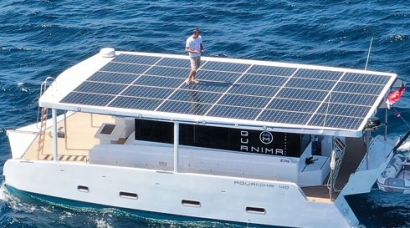
The entire cruise was completed using nothing but the power of the sun to drive the catamaran’s electric motors and charge the batteries to enable nigh-time cruising and usage of all navigation / domestic systems including induction stove, fridge, hot water, air conditioning, filling of the five dive tanks, regular charging of the Azura Marine Manta 2.0 electric outboard on the yacht’s Zodiac tender and fresh water production.
The objective of the circumnavigation was not only to test the range capabilities of the yacht, but also to test her in a wide variety of weather conditions while also putting all of the yachts onboard systems to the test to show how the yacht truly performs in scenarios as would be encountered by the cruising owner.
“It’s been an incredible and enjoyable experience and, let us be honest, this is a world premiere!” commented Azura Marine CEO Julien Mélot, adding “some doubts have been raised by the online community about the sea worthiness and windage of our first Aquanima 40 since her launch. Let us just say that in Bali, not a single leisure craft - or large cruise vessel for that matter - is leaving its moorings in the windy month of August (winds average at 15 knots from June through to the end of August in Bali, with big swells coming straight from the Southern Indian Ocean.) Yet, we casted off despite the unequivocal reluctance of the authorities to issue our cruising permit. For us, this was the golden opportunity to prove that not only the boat is safe in tough conditions but that she can cruise limitlessly in those conditions without burning a single drop of fuel, while offering great comfort to her guests, of course.
“With this circumnavigation, we have finally been able to put the yacht to the real test. Can we sail in 20+ knot constant wind with choppy seas and overcast skies? Yes. Can we sail at night? Yes. Can we fill five dive tanks every day from solar power without substantially affecting the boat’s range? Yes. Can we recharge the electric tender battery after using it all day whilst diving? Yes. Can we use every system in the galley including fridge, hob and oven without being concerned about battery consumption? Yes. Can we stand on the roof at night, star gazing and fly drones to capture incredible images of the yacht with her underwater and roof lights making the whole bay glow? Yes!” he concluded
A huge mix of weather conditions was encountered including clear calm days, all day winds of over 20 knots, four knot head currents when passing through the tight Bali/Java straits, swells of over three metres and completely cloudy days with no apparent sunlight.
The yacht was able to stop at anchor in several stunning bays under the gaze of volcanoes to enable her crew to take photographs and also dive in a pristine marine park. The galley was used abundantly to cook up a multitude of meals including some fine local and international fares.
This cruise and recent sea trials have proven the yachts’ ability to cruise non-stop, 24/7 on solar energy only. With approximately 30% overcast conditions, the solar roof produced an average of 45 kWh per day. Peak solar power production was 10 700 W with typical daytime production of 8 kW per hour between 10AM and 2PM while consumption by the motors, navigation and domestic systems (fridge, air conditioning etc) were between 2 and 6 kW per hour.
Customers can increase speed and reduce energy consumption by opting for a mast and sails package which will even be capable of upwind performance. All yachts carry an automatically engaged emergency generator should the operator misuse the onboard energy management system.

